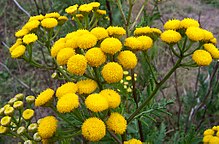Tanacetum
| Tanacetum | |
|---|---|
 |
|
| Tanacetum vulgare | |
| Scientific classification | |
| Kingdom: | Plantae |
| (unranked): | Angiosperms |
| (unranked): | Eudicots |
| (unranked): | Asterids |
| Order: | Asterales |
| Family: | Asteraceae |
| Subfamily: | Asteroideae |
| Tribe: | Anthemideae |
| Genus: |
Tanacetum L. (1753) |
| Type species | |
|
Tanacetum vulgare L. |
|
| Species | |
|
about 160, see text |
|
| Synonyms | |
|
Balsamita Mill.
Sources: ING, E+M, IPNI, GRIN |
|
about 160, see text
Balsamita Mill.
Sources: ING, E+M, IPNI, GRIN
Tanacetum is a genus of about 160 species of flowering plants in the aster family, Asteraceae, native to many regions of the Northern Hemisphere. They are known commonly as tansies. The name tansy can refer specifically to Tanacetum vulgare, which may be called the common tansy or garden tansy for clarity.
Other familiar species include costmary (T. balsamita) and feverfew (T. parthenium).
Tansies are mainly perennial herbs, but some are annuals and subshrubs. Some are a few centimeters tall and some reach 1.5 meters. They vary in form, with one or more branching stems growing erect or prostrate, usually from rhizomes. They are hairy to hairless in texture, and most are aromatic. The leaves are alternately arranged, the blades sometimes borne on petioles. They are usually deeply lobed and may have toothed edges. Most species have flowers in loose or dense inflorescences. The flower has layers of distinct phyllaries around its base and may be flat to hemispheric in shape. The flower has many yellow disc florets, sometimes over 300. Some species have ray florets in shades of yellow, or white with yellowish bases. Some species lack true ray florets but have flat yellowish disc florets that look like rays. The fruit is a ribbed, glandular cypsela, usually with a pappus on the end.
Species include:
...
Wikipedia
